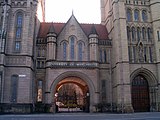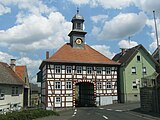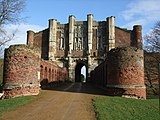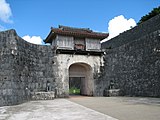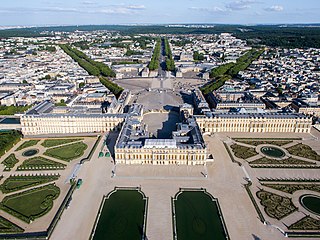
A château is a manor house or residence of the lord of the manor, or a fine country house of nobility or gentry, with or without fortifications, originally, and still most frequently, in French-speaking regions.

Bodiam Castle is a 14th-century moated castle near Robertsbridge in East Sussex, England. It was built in 1385 by Sir Edward Dalyngrigge, a former knight of Edward III, with the permission of Richard II, ostensibly to defend the area against French invasion during the Hundred Years' War. Of quadrangular plan, Bodiam Castle has no keep, having its various chambers built around the outer defensive walls and inner courts. Its corners and entrance are marked by towers, and topped by crenellations. Its structure, details and situation in an artificial watery landscape indicate that display was an important aspect of the castle's design as well as defence. It was the home of the Dalyngrigge family and the centre of the manor of Bodiam.

A barbican is a fortified outpost or fortified gateway, such as at an outer defense perimeter of a city or castle, or any tower situated over a gate or bridge which was used for defensive purposes.

A manor house was historically the main residence of the lord of the manor. The house formed the administrative centre of a manor in the European feudal system; within its great hall were usually held the lord's manorial courts, communal meals with manorial tenants and great banquets. The term is today loosely applied to various English country houses, mostly at the smaller end of the spectrum, sometimes dating from the Late Middle Ages, which currently or formerly house the landed gentry.

Vitré is a commune in the Ille-et-Vilaine department in Brittany in northwestern France.

Hylton Castle is a stone castle in the North Hylton area of Sunderland, Tyne and Wear, England. Originally built from wood by the Hilton family shortly after the Norman Conquest in 1066, it was later rebuilt in stone in the late 14th to early 15th century. The castle underwent major changes to its interior and exterior in the 18th century and it remained the principal seat of the Hylton family until the death of the last Baron in 1746. It was then Gothicised but neglected until 1812, when it was revitalised by a new owner. Standing empty again until the 1840s, it was briefly used as a school until it was purchased again in 1862. The site passed to a local coal company in the early 20th century and was taken over by the state in 1950.

The Château de Largoët, also known as the Tours d’Elven, is a medieval castle in Elven, in the Morbihan département of France, 13 km from Vannes.
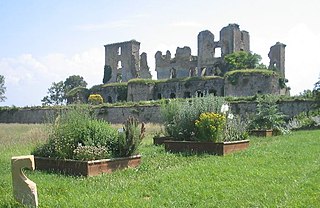
The Château de Lagarde is a ruined castle situated near the village of Lagarde, 8 km (5 mi) southeast of Mirepoix in the French département of Ariège.

The Château de Vitré is a medieval castle in the town of Vitré, in the Ille-et-Vilaine département of France.

The Château de Suscinio or de Susinio is a Breton castle, built in the late Middle Ages, to be the residence of the Dukes of Brittany. It is located in the commune of Sarzeau in the département of Morbihan, near the coast of the Atlantic Ocean. The spectacular site comprises the moated castle, a ruined chapel, a dovecote, and a few ruined outbuildings.

The Château de Chambonneau is a castle in the commune of Gizay in the Vienne department of France that still shows good parts of the original "chateau fort". It is built down a hill, close to the Miosson. The original castle dates from the time of Philippe VI, the beginning of the 14th century. The present château dates between 1335 and 1609. The remaining original parts represent the keep and 75% of the towers and lower buildings.
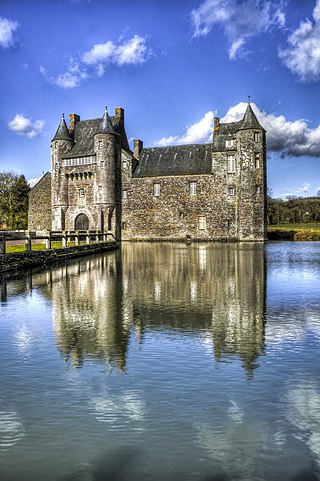
The Château de Trécesson is a medieval castle in the Brittany region of France. It is located in the commune of Campénéac near the Paimpont forest and on the edge of the military camp of Coëtquidan. It is a private property. It has been listed since 2012 as a monument historique by the French Ministry of Culture.

The Château du Plessis-Josso is a fortified 14th century manor house in the Morbihan département of France. The manor is located in the town of Theix, near Vannes. The manor-house is open for tours during the summer, and offers its main hall for hosting events and marriages as well as a small country cottage outside the enclosing walls.

Old Beaupre Castle is a ruined medieval fortified manor house located in the community of Llanfair, outside Cowbridge in Wales. It is known in historic documents under the names Beawpire, Bewerpere, Bewpyr and Y Bewpur. It is a Grade I listed building and is under the care of Cadw. It can be visited free of charge all year round by members of the public. The gardens are designated Grade II on the Cadw/ICOMOS Register of Parks and Gardens of Special Historic Interest in Wales.
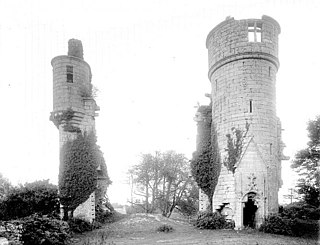
The Château de Rustéphan is a small, ruined 15th–16th-century manor-house in Nizon, part of the commune of Pont-Aven in the Finistère département of France. It was erected by Jean du Faou, chamberlain of France and grand seneschal of Brittany, who built the domaine in 1420.

The Manoir de Mézarnou is a fortified 16th century manor-house located in the Finistère département of Brittany in northwestern France. It is located in the small rural town of Plounéventer, near Landivisiau. It was erected by Yves de Parcevaux, who reorganised the domaine between 1571 and 1591.

The Château de Blain or Château de la Groulais, is a mediaeval castle constructed in the 13th century and heavily remodelled in the 16th, located in the commune of Blain in the Loire-Atlantique département of France. It formed part of the frontier defences of Brittany along with the towns and castles of Vitré, Fougères, Châteaubriant, Ancenis and Clisson.

The Château de Saint-Ilpize is a ruined castle in the commune of Saint-Ilpize in the Haute-Loire département of France. The medieval town of Saint-Ilpize clings to a basalt rock on which stands the castle. Within the castle's walls is a 14th-century chapel built of polychromatic tufa; a basalt gable wall houses the church bells.

The Château de Châteaubriant is a medieval castle strongly modified during the Renaissance, located in the commune of Châteaubriant in the Loire-Atlantique département of France. The original castle was founded in the 11th century on the eastern border of Brittany and, such as the fortresses in Vitré, Fougères, Ancenis and Clisson, it was defending the duchy against Anjou and the Kingdom of France.

The Château d'Ancenis is a castle in the town and commune of Ancenis in the Loire-Atlantique département of France. The castle is on the bank of the Loire.

